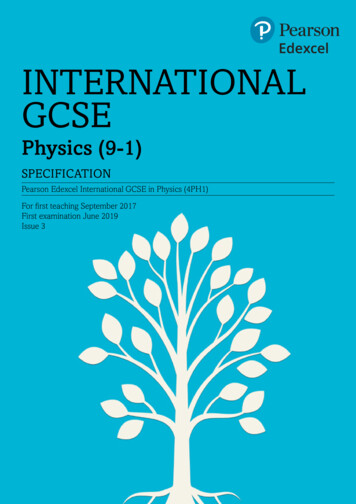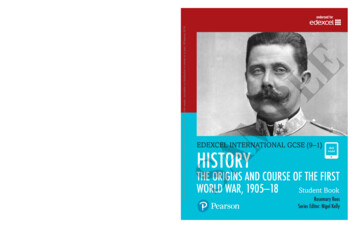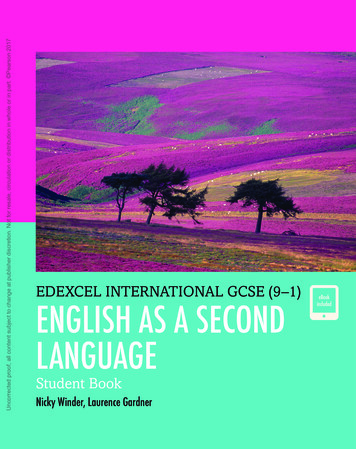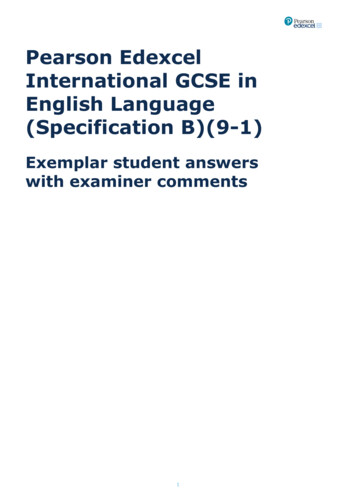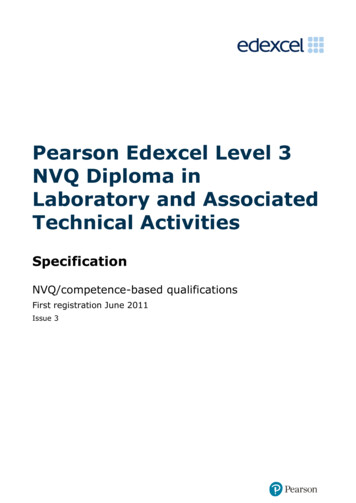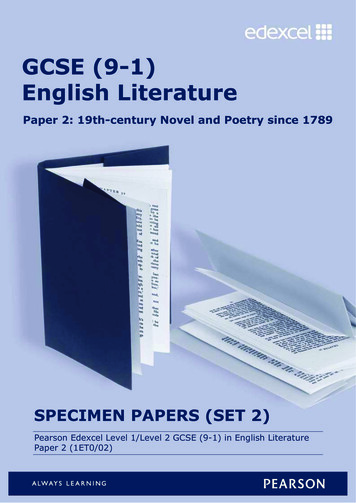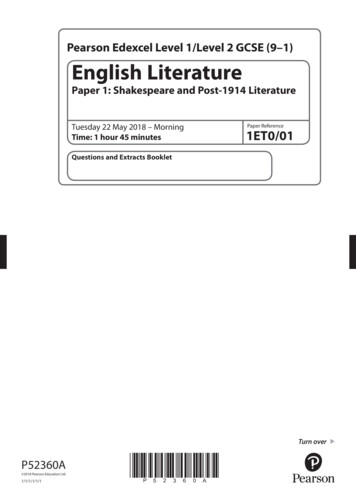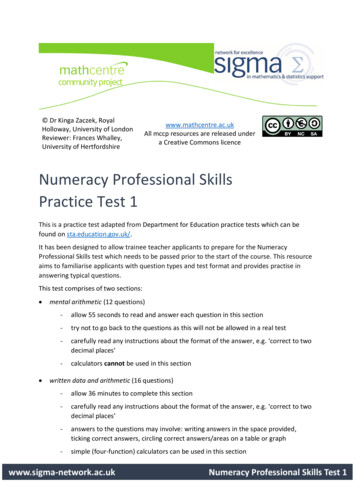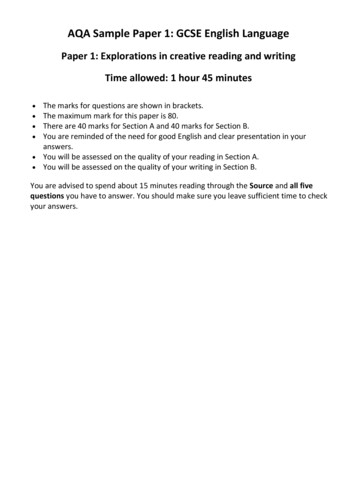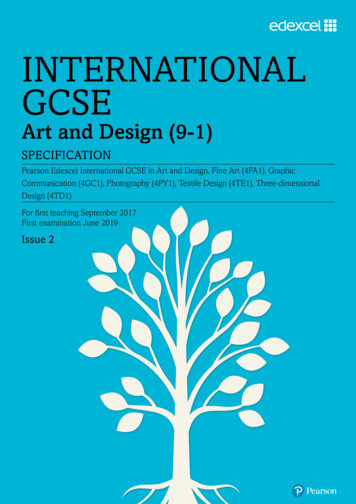
Transcription
INTERNATIONALGCSEArt and Design (9-1)SPECIFICATIONPearson Edexcel International GCSE in Art and Design, Fine Art (4FA1), GraphicCommunication (4GC1), Photography (4PY1), Textile Design (4TE1), Three-dimensionalDesign (4TD1)For first teaching September 2017First examination June 2019Issue 2
Edexcel, BTEC and LCCI qualificationsEdexcel, BTEC and LCCI qualifications are awarded by Pearson, the UK’s largest awardingbody offering academic and vocational qualifications that are globally recognised andbenchmarked. For further information, please visit our qualifications website atqualifications.pearson.com. Alternatively, you can get in touch with us using the details onour contact us page at qualifications.pearson.com/contactusAbout PearsonPearson is the world's leading learning company, with 35,000 employees in more than70 countries working to help people of all ages to make measurable progress in their livesthrough learning. We put the learner at the centre of everything we do, because whereverlearning flourishes, so do people. Find out more about how we can help you and yourlearners at qualifications.pearson.comThis specification is Issue 2. Key changes are sidelined. We will inform centres of anychanges to this issue. The latest issue can be found on our his specification has been produced by Pearson on the basis of consultation with teachers,examiners, consultants and other interested parties. Pearson would like to thank all thosewho contributed their time and expertise to the specification’s development.References to third party material made in this specification are made in good faith. Pearsondoes not endorse, approve or accept responsibility for the content of materials, which maybe subject to change, or any opinions expressed therein. (Material may include textbooks,journals, magazines and other publications and websites.)All information in this specification is correct at time of going to publication.ISBN 978 1 446 94948 1All the material in this publication is copyright Pearson Education Limited 2017
Summary of Pearson Edexcel International GCSE in Art andDesign Issue 2 changesSummary of changes made between previous issue and this currentissuePagenumberAmendments to the wording of the assessment criteria within theAssessment Grid to use consistent wording for each mark band.42–44
Contents12About this specification1Using this specification1Qualification aims and objectives2Why choose Edexcel qualifications?3Why choose Pearson Edexcel International GCSE in Art andDesign?4Supporting you in planning and implementing this qualification5Qualification at a glance6Component overview6Content9Specification updates1Course structure11Fine Art (4FA1)13Overview13Knowledge, understanding and skills in Fine Art13Areas of study for Fine Art14Drawing14Lens-/light-based media14Mixed media14Printing14Painting14Sculpture15Drawing and other materials processes15Graphic Communication (4GC1)Overview1717Knowledge, understanding and skills in Graphic Communication 17Areas of study for Graphic Communication18Advertising18Communication graphics18Design for print18Illustration18Interactive design, including web, app and game18Multi-media18Package design19Signage19Typography19
Drawing and other materials processesPhotography (4PY1)21Overview21Knowledge, understanding and skills in Photography21Areas of study for Photography22Documentary photography22Photojournalism22Studio photography22Location photography22Experimental imagery22Moving image: film, video and animation22Drawing and other materials processes23Textile Design (4TE1)25Areas of study Textile Design26Constructed textiles26Digital textiles26Dyed fabrics26Printed fabrics26Fashion design26Soft furnishings26Stitched and/or embellished textiles27Drawing and other materials processes27Three-dimensional Design (4TD1)31929Overview29Knowledge, understanding and skills in Three-dimensionalDesign29Areas of study of Three-dimensional Design30Architectural design30Interior design30Product design30Environmental/landscape design30Sculpture30Design for theatre, film and television31Jewellery and body adornment31Ceramics31Drawing and other materials processes31Assessment information33Assessment requirements33Component 1: Personal Portfolio34Content overview34
Selection of work34Students must submit:34Component 2: Externally-set Assignment435Content overview35Assessment overview35Detailed description36Preparatory studies36Administration of the 10-hour period of sustained focus37Selection of work38Students must submit:38Assessment Objectives and weightings39Relationship of Assessment Objectives to components39Assessment grid41Applying the assessment grid41International GCSE in Art & Design Assessment Grid42Administration and general information45Entries45Access arrangements, reasonable adjustments, specialconsideration and malpractice45Language of assessment45Access arrangements46Reasonable adjustments46Special consideration46Further information46Candidate malpractice47Staff/centre malpractice47Student recruitment and progression48Prior learning and other requirements48Progression48Appendices49Appendix 1: Codes51Appendix 2: Coursework authentication sheet53Appendix 3: Pearson World Class Qualification Design Principles 55Appendix 4: Transferable skills57Appendix 5: Glossary58
1 About this specificationThe Pearson Edexcel International GCSE in Art and Design is part of a suite of InternationalGCSE qualifications offered by Pearson.This qualification is not accredited or regulated by any UK regulatory body.This specification includes the following key features.Structure: the Pearson Edexcel International GCSE in Art and Design is a linearqualification. All components must be taken at the end of the course of study.Content: features a relevant and engaging body of content that has been updated tocurrent standards.Assessment: comprises a personal portfolio and an externally-set assignment, allowingstudents to demonstrate their creativity and skills through mediums and subjects thatinspire them.Approach: building a foundation for students wishing to progress to the n Edexcel AdvancedLevel in Art and Design, or equivalent qualifications.Specification updatesThis specification is Issue 1 and is valid for the Edexcel International GCSE examination from2019. Pearson will inform centres of any significant changes to the specification. Changeswill also be posted on our website.For more information please visit qualifications.pearson.comUsing this specificationThis specification has been designed to give guidance to teachers and to encourage effectivedelivery of the qualification. The following information will help centres to get the most outof the content and guidance.Compulsory content: as a minimum, all the bullet points in the content must be taught.The word ‘including’ in content specifies the detail of what must be covered.Examples: throughout the content, we have included examples of what could be covered orwhat might support teaching and learning. It is important to note that examples are forillustrative purposes only and that centres can use other examples. We have includedexamples that are easily understood and recognised by international centres.Assessments: use a range of material and are not limited to the examples given. Teachersshould deliver the qualification using a wide range of examples to support the assessment ofthe content.Depth and breadth of content: teachers should use the full range of content and cover allthe Assessment Objectives, see Section 2: Subject content.Pearson Edexcel International GCSE in Art and DesignSpecification – Issue 2 – June 2017 Pearson Education Limited 20171
Qualification aims and objectivesThe aims and objectives of this qualification are to enable students to: actively engage in the creative process of art, craft and design in order to develop aseffective and independent learners, and as critical and reflective thinkers with enquiringminds develop creative, imaginative and intuitive capabilities when exploring and makingimages, artefacts and products become confident in taking risks and learn from experience when exploring andexperimenting with ideas, processes, media, materials and techniques develop critical understanding through investigative, analytical, experimental, practical,technical and expressive skills develop and refine ideas and proposals, personal outcomes or solutions with increasingindependence acquire and develop technical skills through working with a broad range of media,materials, techniques, processes and technologies with purpose and intent develop knowledge and understanding of art, craft and design in historical andcontemporary contexts, societies and cultures develop an awareness of the different roles and individual work practices evident in theproduction of art, craft and design in the creative and cultural industries develop an awareness of the purposes, intentions and functions of art, craft and designin a variety of contexts and as appropriate to students’ own work demonstrate safe working practices in art, craft and design.2Pearson Edexcel International GCSE in Art and DesignSpecification – Issue 2 – June 2017 Pearson Education Limited 2017
Why choose Edexcel qualifications?Pearson – the world’s largest education companyEdexcel academic qualifications are from Pearson, the UK’s largest awarding organisation.With over 3.4 million students studying our academic and vocational qualificationsworldwide, we offer internationally recognised qualifications to schools, colleges andemployers globally.Pearson is recognised as the world’s largest education company, allowing us to driveinnovation and provide comprehensive support for Edexcel students to acquire theknowledge and skills they need for progression in study, work and life.A heritage you can trustThe background to Pearson becoming the UK’s largest awarding organisation began in 1836,when a royal charter gave the University of London its first powers to conduct exams andconfer degrees on its students. With over 150 years of international education experience,Edexcel qualifications have firm academic foundations, built on the traditions and rigourassociated with Britain’s educational system.Results you can trustPearson’s leading online marking technology has been shown to produce exceptionallyreliable results, demonstrating that at every stage, Edexcel qualifications maintain thehighest standards.Developed to Pearson’s world-class qualifications standardsPearson’s world-class standards mean that all Edexcel qualifications are developed to berigorous, demanding, inclusive and empowering. We work collaboratively with a panel ofeducational thought-leaders and assessment experts, to ensure that Edexcel qualificationsare globally relevant, represent world-class best practice and maintain a consistentstandard.For more information on the World Class Qualification process and principles please go toAppendix 3: Pearson World Class Qualification Design Principles or visit our earson Edexcel International GCSE in Art and DesignSpecification – Issue 2 – June 2017 Pearson Education Limited 20173
Why choose Pearson Edexcel International GCSE inArt and Design?We’ve listened to feedback from all parts of the International and UK school subjectcommunity, including a large number of teachers. We’ve made changes that will engagestudents and give them skills that will support progression to further study or work in art,craft or design careers.Courses to suit your students’ needs and interestsThe content and assessment approach in our Art and Design qualification has been designedto meet students’ needs in the following ways: Course flexibility and choice - teachers can design a course of study that appeals tostudents’ interests and the centre’s resourcing. We have updated the areas of study andadded more endorsed title specialisms than in the legacy specification:oFine ArtoGraphic CommunicationoPhotographyoTextile DesignoThree-dimensional Design. Local influence - the opportunity to ‘localise’ the content to make it more relevant forstudents; reflecting local artistic and cultural strengths, e.g. in relation to the areas ofstudy such as: location photography, constructed textiles or fashion design, jewelleryand body adornment or ceramics. Portfolio and Externally Set Assignment - Students develop knowledge,understanding and skills within their chosen endorsed title specialism when completingtheir Personal Portfolio. These are then further developed to complete the Externally SetAssignment. Question papers are straightforward – our question papers are clear and accessiblefor international students of all ability ranges and learning styles. Our mark grid isstraightforward so that the assessment requirements are clear. Broad and deep development of students’ skills; for example all students:oGain awareness of the purposes, intentions and functions of art, craft and designoUse creativity and imagination to express individual thoughtsoDevelop and refine original ideas from initiation to realisationoAnalyse critically their own work and the work of othersoBuild confidence to take risks, experiment and learn from mistakes.Progression to A Level – International GCSEs enable successful progression to A Level andbeyond. Through our World Class Qualification development process we have consulted withteachers as well as higher education professors to validate the appropriateness of thequalification including its content, skills development and assessment structure.More information about all our qualifications can be found on our Edexcel International GCSEpages at qualifications.pearson.com4Pearson Edexcel International GCSE in Art and DesignSpecification – Issue 2 – June 2017 Pearson Education Limited 2017
Supporting you in planning and implementing thisqualificationPlanning Our Getting Started Guide gives you an overview of the Pearson Edexcel InternationalGCSE in Art and Design to help you understand the changes to content and assessment,and what these changes mean for you and your students. We will give you an editable course planner and schemes of work. Our mapping documents highlight the key differences between the new and legacyqualifications.Teaching and learning Our skills maps highlight the opportunities for students to develop skills that are directlyand indirectly assessed. Print and digital learning and teaching resources promote ‘any time, any place’ learningto improve student motivation and encourage new ways of working.Preparing for examsWe also provide a range of resources to help you prepare your students for theassessments, including: specimen papers to support formative assessments and mock exams examiner commentaries following each examination series.ResultsPlusResultsPlus provides the most detailed analysis available of your students’ examperformance. It can help you to identify the topics and skills where further learning wouldbenefit your students.examWizardA free online resource designed to support students and teachers with exam preparation andassessment.Training eventsIn addition to online training, we host a series of training events each year for teachers todeepen their understanding of our qualifications.Get help and supportOur subject advisor service will ensure you receive help and guidance from us.Sign up to receive the Edexcel newsletter at -art.html to keep up to date with qualification updates and product and service news.For more information, email our Subject Advisor at: TeachingArtandDesign@pearson.comPearson Edexcel International GCSE in Art and DesignSpecification – Issue 2 – June 2017 Pearson Education Limited 20175
Qualification at a glanceComponent overviewComponent 1: Personal PortfolioComponent codes: 4FA1/01, 4GC1/01, 4PY1/01, 4TE1/01, 4TD1/01* Internally set Externally marked Availability: June First assessment: June 201950% of the total International GCSEContent summary Students must work within one of the following endorsed titles: Fine Art; GraphicCommunication; Photography; Textile Design; Three-dimensional Design. Students create a personal portfolio of work that demonstrates the knowledge,understanding and skills for the selected endorsed titles. Centres are free to devise any theme(s), project(s) or task(s) which may each havea separate focus or be interconnected. Centre-devised theme(s), project(s) or task(s) must adhere to the submissionrequirements given in the Assessment Requirements section on page 34.This component gives students opportunities to: develop and explore ideas research primary and contextual sources experiment with media, materials, techniques and processes present personal response(s) to theme(s) set by the centre.AssessmentStudents must submit: three sheets of supporting studies (maximum size A2 for each sheet) one sheet of final outcome/s (maximum size A2).**Students’ work must show evidence of all four Assessment Objectives in response tothe internally-set theme(s), project(s) or task(s).All work is internally set and is externally marked using the assessment grid.The total number of marks available for the Personal Portfolio is 72.*See Appendix 1 for a description of these codes and all the other codes relevant to thisqualification.** Students who wish to create work that is larger than A2 size or which is threedimensional must have their work photographed. The photographs will form evidence forthe assessment of the component and it is essential that they are of a quality to dojustice to the students’ work. The photographs should be in colour, and of a sizesufficient to show detail of the piece, A4 for example. It is expected that fourphotographs of each original piece taken from different angles will be sufficient. Thephotographs should be mounted on one side of an A2 sheet, with no overhanging orfolded photos, notes or other material.6Pearson Edexcel International GCSE in Art and DesignSpecification – Issue 2 – June 2017 Pearson Education Limited 2017
Component 2: Externally-set AssignmentComponent codes: 4FA1/02, 4GC1/02, 4PY1/02, 4TE1/02, 4TD1/02* Externally set Externally marked Availability: June First assessment: June 201950% of the total International GCSEContent overview Students must continue to work in the same endorsed title as they did for thePersonal Portfolio. For example, if a student chooses Fine Art for component one,then they must continue with Fine Art for component two. Students must present personal response(s) to an externally set broad-basedthematic starting point, set by Pearson in the Externally Set Assignment.This component allows students opportunities to: develop and explore ideas research primary and contextual sources experiment with media, materials, techniques and processes present personal response(s) to the externally-set theme.AssessmentStudents must submit: three sheets of supporting studies (maximum size A2 for each sheet) one sheet of final outcome/s (maximum size A2).**Students’ work must show evidence of all four Assessment Objectives in response tothe Externally Set Assignment theme.All work is externally set and is externally marked using the assessment grid.The total number of marks available for the Personal Portfolio is 72.*See Appendix 1 for a description of these codes and all the other codes relevant to thisqualification.** Students who wish to create work that is larger than A2 size or which is threedimensional must have their work photographed. The photographs will form evidence forthe assessment of the component and it is essential that they are of a quality to dojustice to the students’ work. The photographs should be in colour, and of a sizesufficient to show detail of the piece, A4 for example. It is expected that fourphotographs of each original piece taken from different angles will be sufficient. Thephotographs should be mounted on one side of an A2 sheet, with no overhanging orfolded photos, notes or other material.Pearson Edexcel International GCSE in Art and DesignSpecification – Issue 2 – June 2017 Pearson Education Limited 20177
8Pearson Edexcel International GCSE in Art and DesignSpecification – Issue 2 – June 2017 Pearson Education Limited 2017
2 ContentFine Art (4FA1)13Graphic Communication (4GC1)17Photography (4PY1)21Textile Design (4TE1)25Three-dimensional Design (4TD1)29Pearson Edexcel International GCSE in Art and DesignSpecification – Issue 2 – June 2017 Pearson Education Limited 20179
10Pearson Edexcel International GCSE in Art and DesignSpecification – Issue 2 – June 2017 Pearson Education Limited 2017
Course structure The Pearson Edexcel International GCSE in Art and Design comprises five endorsed titles,each with content specified in this section: Fine Art (4FA1) Graphic Communication (4GC1) Photography (4PY1) Textile Design (4TE1) Three-dimensional Design (4TD1). Students must work in the same endorsed title for both components in order to beawarded an International GCSE grade. For example, if a student chooses Fine Art forcomponent one, then they must continue with Fine Art for component two. Students can be entered for more than one endorsed title in any examination session.Each endorsed title will be awarded a separate International GCSE grade.Pearson Edexcel International GCSE in Art and DesignSpecification – Issue 2 – June 2017 Pearson Education Limited 201711
12Pearson Edexcel International GCSE in Art and DesignSpecification – Issue 2 – June 2017 Pearson Education Limited 2017
Fine Art (4FA1)OverviewFine art can be defined as work developed primarily to communicate aesthetic, intellectual orpurely conceptual ideas and meaning, rather than to serve a practical or commercialfunction. For example, work could be the outcome of personal experiences, thoughts andfeelings, or simply observation and records of people, places and things in new and uniqueways. Fine art work will demonstrate an understanding and application of formal elementsand creative skills, including mark-making. Students will use visual communicationsensitively and thoughtfully to document their artistic journey and fully support theirintentions.Knowledge, understanding and skills in Fine ArtThere are many skills, techniques, materials, processes and concepts that are essential to allareas of study in fine art. In addition to any specialist requirements listed under the chosenarea(s) of study, students should develop a practical knowledge and understanding of: the use of formal elements and visual communication through a varietyof approaches the use of observational skills to record from sources and communicate ideas characteristics of media and materials such as wet and dry, malleable,resistant and digital properties of colour and light such as hue, tint, saturation and tone the effects and creative potential of combining and manipulating differenttwo-dimensional and three-dimensional materials and media the use of digital and/or non-digital applications.For all areas of study in this endorsed title, students should: undertake visual research, using primary and secondary sources, and recordobservations, experiences and ideas in appropriate ways. Primary sources must includefirst-hand experience of original work develop and realise ideas and outcomes, exploring and reviewing possible solutions andmodifying work appropriately understand and use (appropriately and safely) a range of materials, equipment,processes and techniques in two- and/or three dimensions, using information andcommunication technology, where appropriate know and understand a range of work, from contemporary practice, past practice anddifferent cultures, in order to demonstrate an understanding of continuity and change inart, craft and design.Pearson Edexcel International GCSE in Art and DesignSpecification – Issue 2 – June 2017 Pearson Education Limited 201713
Areas of study for Fine ArtWork must demonstrate integrated knowledge, understanding and skills. Work is not limitedto one area of study and students could develop work in at least one of the following areasof study.Drawing The use of expressive and descriptive mark-making to record andcommunicate ideas. The use of a range of drawing materials, media and techniques such as graphite, pastel,charcoal, ink, chalk, digital drawing applications and a range ofdrawing surfaces.Lens-/light-based media The use of digital, film and/or video elements such as lighting, time, sound, editing,space and composition to communicate ideas. The use of a range of lens- and light-based media, materials and techniques such asmontage, mixed media, installation, animation, studio and location photography, pre-andpost-production manipulation.Mixed media The combining and manipulating of two-dimensional and three-dimensional media tocommunicate ideas. The combination of a range of mixed media materials and techniques such as wet anddry media, collage, objects, textiles, two- and three-dimensional elements, digital andnon-digital application.Printing The creation of surfaces from which an image can be transferred to communicate ideas. The use of a variety of materials, media and techniques such as linoleum, screen,intaglio, relief, lithography, drypoint, etching and monoprint, using a range of inks andprinting surfaces.Painting The use of expressive and descriptive mark-making to record andcommunicate ideas. The use of a range of painting materials, tools and techniques such as gouache,watercolour, acrylic, oil, dyes, brushes, digital painting applications and a range ofpainting surfaces.14Pearson Edexcel International GCSE in Art and DesignSpecification – Issue 2 – June 2017 Pearson Education Limited 2017
Sculpture The creation of form through manipulation of three-dimensional materials tocommunicate ideas. The use of a range of sculpting materials, tools and techniques such as carving,modelling, joining, constructing and reducing, and transposing two-dimensional imagesinto three-dimensional forms.Students who submit work for sculpture for examination must have their workphotographed. The photographs will form evidence for the assessment of the sculpture, andit is essential that they are of a quality to do justice tostudents’ work.The photographs should be in colour, and of a size sufficient to show detail of the piece, forexample A4. It is expected that four photographs of each piece taken from different angleswill be sufficient. The photographs should be mounted on an A2 sheet.Drawing and other materials processesDrawing can be applied in all its forms across traditions and technologies, and it can becritical and accurate as well as explorative and experimental. Drawing takes many formsfrom two-dimensional mark-making, to lines made using materials to define threedimensional space.Drawing is essential to recording from life, describing a mood or emotion, as well ascapturing an expression, atmosphere or tension.Pearson Edexcel International GCSE in Art and DesignSpecification – Issue 2 – June 2017 Pearson Education Limited 201715
16Pearson Edexcel International GCSE in Art and DesignSpecification – Issue 2 – June 2017 Pearson Education Limited 2017
Graphic Communication (4GC1)OverviewGraphic Communication introduces students to a visual way of conveying information, ideasand emotions, using a range of graphic media, processes, techniques and elements such ascolour, icons, images, typography and photographs. Students should conduct primary andsecondary investigations during their design development, and explore traditional and/ornew technologies. They should also consider the use of signs and symbols, and the balancebetween aesthetic and commercial considerations.Knowledge, understanding and skills in Graphic CommunicationThere are many skills, techniques, materials, processes and concepts that are essential to allareas of study in Graphic Communication. In addition to any specialist requirements listedunder the chosen area(s) of study, students should develop a practical knowledge andunderstanding of: the use of formal elements and visual communication through a varietyof approaches the use of observational skill to record from sources and communicate ideas graphic materials and techniques such as traditional and digital graphics, printing andweb-based technologies properties of colour and light such as hue, tint, saturation and tone the effects and creative potential of combining and manipulating different twodimensional and three-dimensional materials and media the use of digital and/or non-digital applications.For all areas of study in this endorsed title, students should: undertake visual research, using primary and secondary sources, and recordobservations, experiences and ideas in appropriate ways. Primary sources must includefirst-hand experience of original work develop and realise ideas and outcomes, exploring and reviewing possible solutions andmodifying work appropriately understand and use (appropriately and safely) a range of materials, equipment,processes and techniques in two- and/or three dimensions, using information andcommunication technology, where appropriate know and understand a range of work, from contemporary practice, past practice anddifferent cultures, in order to demonstrate an understanding of continuity and change inart, craft and design.All the work for this endorsed title can be produced in digital form. Students are encouragedto explore the creative potential of software packages and realise their ideas through avariety of media.Students who plan to submit work for graphic design examination should obtain permissionfrom the examination centre if they wish to take equipment such as computers and softwareinto the examination venue.Pearson Edexcel International GCSE in Art and
Studio photography 22 Location photography 22 Experimental imagery 22 Moving image: film, video and animation 22 Drawing and other materials processes 23 Textile Design (4TE1) 25 Areas of study Textile Design 26 Constructed textiles 26 Digital textiles 26 Dyed fabrics 26 Printed fabrics
